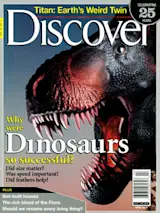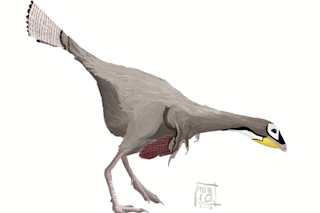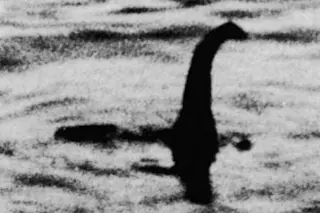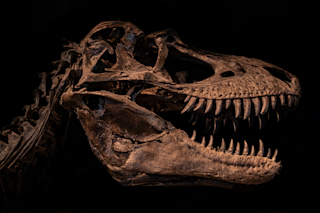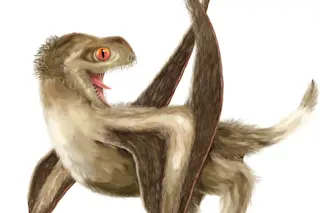In the earliest paintings of dinosaurs, from the mid-1800s, they writhe like beached sea serpents or slouch like reptilian potbellied pigs. Now we know better. Dinosaurs stood erect and walked or ran great distances. Many were huge. One species—Argentinosaurus—reached 125 feet long. Now we know dinosaurs had complicated social lives—they raised their young, and they probably lived and hunted together in herds. We even know that the 9,000 species of birds all around us are living, feathered dinosaurs.
We know better because paleontologists are unearthing astounding numbers of fossils. “There are six or seven new species described every year,” says paleontologist Paul Sereno at the University of Chicago. “Even though you’d think it might be slowing down, the pace of discovery has quickened.” Modern technological devices, like CT scanners that illuminate hidden recesses of skulls and molecular probes that detect ancient proteins, offer a new depth of understanding scientists could never have dreamed of only a decade ago.
We know better, but dinosaurs remain highly mysterious. “It’s still humbling how little we know,” says Hans-Dieter Sues of the Smithsonian Institution. “Most of the big questions have yet to be really answered.”
A Discover survey of paleontological studies around the world identifies those questions as well as the tantalizing new clues that could lead to answers.

Eoraptor, an early dinosaur that first appeared 228 million years ago, grabs lunch. Eoraptor was a primitive three-foot-long theropod and likely feasted on a variety of small prey, including lizards, bugs, and worms. Here it has captured a mammal-like cynodont dubbed Probelesodon. In the background is a herd of the herbivorous dicynodont Ischigualastia. Cynodonts and dicynodonts predate dinosaurs and may be an evolutionary link between reptiles and mammals. | Illustration by Mick Ellison and David Krentz
1. Why did dinosaurs conquer Earth 210 million years ago?
Dinosaurs were not the first vertebrates to walk on land. If you had visited Earth during the Triassic Period, which began with a mass extinction 250 million years ago (see “The Day Everything Died,” page 64), you would have encountered the ancestors of today’s lizards, turtles, and alligators. The forerunners of humans—reptilelike precursors of mammals—were common. Yet once dinosaurs emerged into this bustling world, they became the dominant herbivores and predators.
Scientists once theorized that even the earliest dinosaurs must have been intrinsically superior to other animals. “We tended to look for the logic of evolution—there had to be a reason for the success of dinosaurs,” Sereno says. But doubts about this theory grew as researchers discovered new species. Now we know that although the earliest dinosaurs appeared roughly 230 million years ago, they remained relatively rare for the rest of the Triassic. Various reptiles and the forerunners of mammals dominated the landscapes. Sereno asks the obvious question: Why did it take so long for dinosaurs to become the major species? “Why were these other clunky animals the most common thing you stumbled over? It just doesn’t make sense.”
It’s possible that another mass extinction—210 million years ago—killed off the competition dinosaurs faced. That extinction, which involved the demise of more than half of all species on land and sea, is just as mysterious as the mass extinction that began the Triassic 40 million years earlier. Some geologists speculate that massive volcanic eruptions covering areas as large as modern continents triggered the release of methane buried in the ocean floor, causing a greenhouse effect. There is little doubt that the eruptions happened, but there is uncertainty that they occurred before the extinctions. They may have erupted soon afterward.
Paul Olsen, a paleontologist at Columbia University, offers an alternative theory: Yet another large asteroid smacked Earth. He and his colleagues have found layers of rock from the end of the Triassic that are loaded with iridium, a marker rare on Earth but common in asteroids, as well as spores of ferns, which would have quickly sprouted after an asteroid impact wiped out the world’s forests.
Olsen’s team then added dinosaurs to their time line. In the eastern United States and Canada, Olsen has studied over 10,000 footprints of late Triassic dinosaurs and other land animals. He and his colleagues found that right at the end of the Triassic Period, many nondinosaur footprints suddenly disappeared, and dinosaur footprints became much more common. And as the footprints became more common, the dinosaurs also got bigger, in some cases doubling their mass.
While many paleontologists are intrigued by Olsen’s evidence, others have scoffed. “People have a very violent reaction to this,” says Olsen, who readily admits that it’s hard to choose between an asteroid and volcanoes with the scant evidence at hand. “Deep in my heart I am quite ambivalent about whether an asteroid was involved.”
2.How did those long-necked plant eaters get so big?
Some vertebrates, such as birds and mammals, grow fast when they’re young and then stop growing altogether when they reach adult size. Alligators and many other reptiles don’t have such a big initial spurt. Instead, they grow slowly for their entire lives. These different growth patterns leave marks on bones. Fast-growing animals expand their bones continually when they’re young, and some of their old tissue gets destroyed as new bone forms. By contrast, the bones of many slow-growing animals look like tree rings because the animals grow in short bursts.
These microscopic clues survive in fossils. For example, researchers have studied the bones from an 80-million-year-old crocodile called Deinosuchus that could grow to 50 feet long. They concluded that it reached its huge size the way crocodiles do today, growing for 50 years or more.
Dinosaurs were different. “They did not grow like typical reptiles,” says Kevin Padian, a paleontologist at the University of California at Berkeley. Tyrannosaurus rex, for example, took only 20 years to reach full size. But the biggest dinosaurs were off the charts. Apatosaurus (also called Brontosaurus), one of the long-necked plant eaters known as sauropods, needed only 15 years to reach 25 tons. “They’re just growing faster than anything on land today,” says Padian.
The physiology behind this feat remains a mystery. Equally puzzling is the fact that dinosaurs managed to reach such big sizes, while the land animals that came before and after them never came close. Some researchers have proposed an environmental explanation: Perhaps levels of carbon dioxide were unusually high, producing lush vegetation that could fuel the dinosaur boom. But for now that is just speculation. “We don’t have a good answer why dinosaurs were such big animals,” says Hans-Dieter Sues.
3. Were dinosaurs warm blooded?
If a bass swims in chilly water, its body becomes chilly. If it swims in warm water, it becomes warm. Put an otter in the same cold or warm water, however, and its body temperature barely changes. Living animals vary tremendously in their metabolism, and one of the biggest outstanding questions about dinosaurs is where they fall between the bass and the otter.
Reptiles are cold blooded. Or more precisely, they have a low metabolic rate and can’t produce enough heat to keep their bodies warm. When dinosaurs were first discovered, paleontologists considered them overgrown reptiles, which presumably meant they must be cold blooded too. Doubts emerged about the cold-blooded dogma three decades ago, when studies of birds, which are warm blooded, suggested they evolved from dinosaurs. Diehards have argued that, at least for the larger dinosaurs, there would be no advantage in being warm blooded. Their bodies could store plenty of heat from the sun. Meanwhile, other paleontologists have tried to find a clear-cut marker for warm-bloodedness in fossils, but without much luck. At the moment, the most promising clues come from the study of dinosaur growth. According to Kevin Padian, the results fit better with warm-blooded dinosaurs.
“Look, these things are sustaining rapid growth the way only warm-blooded animals do today,” says Padian. “Unless a physiologist can tell us otherwise, it’s much more reasonable to say dinosaurs had evolved warm-bloodedness.”

Giganotosaurus goes on the prowl. The theropod thrived 100 million years ago, some 25 million years before T. rex. Roughly six feet bigger than T. rex and a ton or two heavier, Giganotosaurus nonetheless was a relatively fast dinosaur whose pointed tail apparently provided balance and the ability to make quick turns as it ran. Fossil evidence suggests its prey included Argentinosaurus, a 125-foot-long herbivore. | Illustration by Mick Ellison and David Krentz
4. How fast did T. rex and other predatory dinos run?
Earlier generations of museumgoers
gazed on slouching, tail-dragging dinosaurs. But when the notion of warm-blooded dinosaurs took hold, goliaths like Triceratops and Tyrannosaurus rex got a spring in their step. Since Triceratops had legs proportioned like those of a rhinoceros, some researchers concluded that they charged at a full gallop. And predatory dinosaurs became the leopards of the Mesozoic Era, with T. rex hitting 40 miles an hour. It was a startling vision, and it made
Jurassic Park a hit.
Now scientists are finally putting this image of dinosaurs to a real biomechanical test. “We didn’t have any data before, no evidence, nothing—just pure conjecture,” says Mark Norell of the American Museum of Natural History. But that’s changing, largely because of the work of John Hutchinson, a researcher at the Royal Veterinary College in London.
As a graduate student at Berkeley, Hutchinson studied T. rex bones for clues about the shape and size of the dinosaur’s muscles. “I wanted to start with the anatomy and build up from there, instead of rushing straight into a Jurassic Park model,” says Hutchinson. “The foundations had to be laid first.” He built a computer model that could calculate the forces acting on the joints of a running bipedal creature in midstride and tell him how much muscle the animal would need in order not to collapse. Then he refined the model to incorporate data derived from the muscle tissue of living animal species, ranging from chickens to kangaroos (which he dissected himself). “I could easily build a model of T. rex jumping over skyscrapers, and it might look convincing,” says Hutchinson. “But unless it has been validated with living animals, it’s mostly useless.”
Hutchinson eventually constructed a virtual T. rex and calculated how much muscle it would need to run fast. He found that each leg would need 40 percent of the dinosaur’s entire muscle mass. Hutchinson concluded there was no plausible way T. rex could run 40 miles an hour. He has now upgraded his model to a three-dimensional version, complete with 33 muscles in each leg. It gives him the same results.
Hutchinson can’t say yet just how fast T. rex could run, but he suspects an upper limit of maybe 25 miles an hour. “That’s pretty good—the same as an Olympic sprinter,” he says. “But it’s nowhere near 40 miles an hour. You’d have to give it ridiculously huge leg muscles.” Moreover, Hutchinson concluded T. rex didn’t need incredible speed to hunt prey. “I don’t think there’s a reason for it to move that fast, especially when you look at the big, clunky animals it was eating,” he says. “My picture of that ecosystem is not a Formula One race.”
5. Were dinosaurs social animals and good parents?
Animals can be solitary or huddle together in big herds. Some live in a fierce hierarchy, with bloody battles for the top positions. Others live more amiably in cooperative groups. Some abandon their eggs as soon as they’ve laid them, while others dote on their young for years. But unlike scientists who study modern species, paleontologists can’t sit on a hillside and use binoculars to observe the social life of dinosaurs. Instead, they have to squeeze clues out of their fossils.
It’s a hard process, because a lot of different conclusions can be drawn from the same fossils. Consider bone beds—sites where many fossils of the same dinosaur species have been unearthed. They might have formed when an entire herd of dinosaurs got stuck in quicksand all at once, or they might be the result of individuals getting stuck over the course of a few centuries.
Despite these ambiguities, paleontologists now generally agree that at least some dinosaur species lived in big herds. “That’s pretty much settled at this point,” says Paul Sereno. Sauropods left behind tracks in the western United States that appear to run north and south, suggesting that they even migrated long distances together—presumably searching for fresh vegetation to eat. And in recent years, paleontologists have found collections of fossils resembling T. rex that suggest predatory dinosaurs may have traveled in hunting packs. “That’s scary,” says Padian.
As for how dinosaurs cared for their young, paleontologists have looked to the closest living relatives of dinosaurs—alligators and birds—for possible models. Birds sit on their eggs to incubate them and give a lot of care to their young, which are relatively helpless when they’re born. Alligators aren’t as attentive. “The mothers help their babies to the water, but in a few days they’re on their own,” says Sues.
Dinosaurs seem to have varied between these two extremes. “One size doesn’t have to fit all of these critters,” says Padian. Paleontologists have found huge nesting grounds of sauropod eggs in Argentina, which the giant sauropods may have buried in moist earth and covered with vegetation. In Mongolia, on the other hand, a theropod has been found sitting on its eggs much like a bird brooding on its nest. (It is probably no coincidence that this theropod is also closely related to birds.)
What happened after dinosaur eggs hatched is less clear. In the 1980s a team led by Jack Horner of Montana State University discovered fossils of adult and baby dinosaurs in the same sites, which suggested the parents were taking care of their hatchlings. But it wasn’t until this year that paleontologists uncovered a seemingly clear-cut case of parental care: David Varricchio of Montana State and his Chinese colleagues reported a small plant-eating dinosaur sitting with 34 young dinosaurs. Whether all 34 were its own babies or whether it was part of a cooperative colony of adults, Varricchio can’t say.
With so little evidence to go on, paleontologists can’t confidently say much more about dinosaur social lives. They can’t even tell for sure whether a dinosaur fossil is male or female. But that doesn’t mean the mysteries will never be solved. “These questions are slowly going to be answered,” Mark Norell predicts.
6. Why did Triceratops and its relatives look so strange?
Triceratops had three horns on its face along with a huge bony frill that extended from the back of its head. It’s easy to picture the animal using the frill to block a predator’s lunge for its neck, or goring its attacker with one of its horns. But this picture is probably fiction. “Pretty much everybody rules out defense for the horns and frills,” Norell says. “They just weren’t sturdy enough, and we don’t find a lot of broken ones.”
Paleontologists have had the same counterintuitive experience with Pachycephalosaurus, a bipedal plant eater with a dome of thick bone on its skull that was studded with knob-shaped outgrowths. Generations of paleontologists favored the idea that males rammed their heads together the way bighorn sheep do today. But on closer inspection it turns out that the dome was covered with tissue rich with blood vessels. One good head butt would leave Pachycephalosaurus badly wounded.
Kevin Padian and Jack Horner think they can explain these frills and horns and domes, as well as the strange ornaments on other dinosaurs. “We’re proposing that all these crests and frills and horns and plates and stuff have nothing to do with mechanical things,” says Padian. “Rather, they are for species recognition.”
Many living animals carry identity badges—horns, bright colors, and such—that allow them to be recognized as members of a particular species. These identity badges may help animals avoid interbreeding with closely related species that share their range. Antelope horns, for example, vary a lot from species to species, not because these variations let them fight off different predators but because they need to recognize their own kind.
Padian and Horner theorize that identity badges were also common among dinosaurs. Triceratops, for example, belongs to a big group of species called ceratopsians, many of which had frills and horns in a dizzying variety of shapes and sizes. You would expect that when a lot of ceratopsian species lived side by side, they would evolve a bigger variation of ornaments than more solitary species. “We think they passed the test,” says Padian.
7. How did some dinosaurs evolve feathers?
The first fossil feathers were discovered in 1861 in a limestone quarry in Germany, where workers unearthed a 145-million-year-old bird, Archaeopteryx. It still retained signs of its reptilian past, such as the teeth in its beak, the claws on its winged fingers, and its long tail. But which reptiles were its ancestors was the subject of fierce debate for more than a century.
In the 1970s a growing number of paleontologists theorized that birds are living dinosaurs. They pointed out a number of features in bird skeletons that could also be found in one group of midsize bipedal meat eaters known as dromaeosaurs. Feathers, they suggested, might have first evolved in dromaeosaurs, but it would be hard to test this hypothesis since feathers rarely fossilize. “If you had asked me 15 years ago if we would ever find traces of feathers on a dinosaur, I would have said, ‘Yeah, but not in my lifetime,’ ” says Sereno.
Sereno is still alive and well, and more than a dozen species of wingless feathered dinosaurs have emerged in northeastern China. The most surprising thing about these fossils is that they include a forerunner of T. rex as well as predators related to dromaeosaurs. That leads to one obvious conclusion. “Feathers did not evolve for flight,” says Padian.
Fossils are not the only source of clues to the evolution of feathers; bird embryos are as well. A feather begins as a hollow tube. It then produces barbs that hook together loosely. This design can lead to the downy feathers that keep birds warm. In other cases, a feather will produce more hooks that lock the barbs into straight rows, creating the flat surface that birds use to fly.
In 1999 Richard Prum of Yale University and Alan Brush of the University of Connecticut proposed that these growth patterns reflect how feathers evolved. Paleontologists have now found enough feathered dinosaurs to test their theory, and it is holding up well. The feathered dinosaurs most distantly related to birds had hollow tubes sprouting from their skin. More closely related species had a few barbs branching from a central axis. And the feathered dinosaurs that were the closest relatives of birds had the most complex feathers.
What’s not clear is what purpose the protofeathers of dinosaurs served. In the early stages of their evolution, feathers may have served in mating displays or species recognition. If T. rex and other theropods evolved warm-bloodedness, feathers could have helped them insulate their bodies to stop heat loss. For now, no one knows for sure.
8. How did some feathered dinosaurs begin to fly?
Dinosaurs needed more than just feathers to fly. They had to evolve the special arrangement of bones and muscles that makes it possible for birds to flap their wings. Traditionally, paleontologists have put forward alternative scenarios in which flight evolved either from the trees down or the ground up.
In the trees-down scenario, tree-climbing dinosaurs jumped to the ground or to other trees, and feathers on their outstretched forelimbs helped extend their fall. Eventually their descendants became gliders, and then finally they began to flap their wings. In the ground-up scenario, small theropods somehow evolved a flight stroke even while they were adapted for running on the ground—perhaps by grabbing prey with their hands.
“This was a false dichotomy,” says Hans-Dieter Sues. In recent years, for example, scientists have discovered some very small feathered theropods that may have been able to climb trees. Meanwhile, Ken Dial of the University of Montana has found that partridges can run up vertical surfaces. As the birds run, they flap their wings so that they act like spoilers on a race car, pushing the bird against the surface.
“We’ve got animals able to climb trees if they want to, able to take off from the ground if they have to,” says Padian.
These discoveries have prompted paleontologists to give feathered dinosaurs a fresh look. It’s possible that some of them may have already been able to fly, if only a little. “The only way this will really be answered is to get some better fossils, build really good models, and do experiments in wind tunnels,” says Norell.
9. What finally killed off the dinosaurs?
Birds may be living dinosaurs, but they’re peculiar ones. They are the only dinosaurs that managed to survive beyond the Cretaceous Period, which ended 65 million years ago. All the dinosaurs without wings became extinct, along with roughly 75 percent of all other species—a pulse of mass extinctions that struck land and sea alike.
What happened? For one thing, a six-mile-wide asteroid crashed into the Gulf of Mexico at the very end of the Cretaceous Period. It left behind many signs of its impact, from bits of fractured quartz showered thousands of miles away and vast arcs of tidal-wave-driven debris to the impact crater itself, buried deep underground off the Yucatán Peninsula.
A number of researchers have argued that cascading environmental effects from the impact wiped out the dinosaurs in a geologic blink. As debris from the impact rained down around the world, it triggered vast wildfires. Dust may have blocked sunlight for months, and acid rain may have killed off plants and marine organisms long afterward. Cut off from their food supply, most dinosaurs became extinct. Birds survived because a few of them happened to be sheltered in burrows or rock piles.
When this hypothesis emerged in the 1980s, it was hugely popular. “Fifteen or 20 years ago, people would have said, ‘Ah, it’s just the asteroid,’ ” says Norell. But things have changed. “Now everybody agrees that an asteroid hit, but its role in the extinctions is being questioned,” he says.
Recent studies suggest that the impact may not have been quite as fierce as scientists once thought. A team of Canadian and British researchers surveyed six sites in North America and found no sign of soot 65 million years ago, leading them to doubt that the impact led to a global firestorm. Gerta Keller of Princeton University has also found reason to doubt in a core she drilled from the impact crater itself. She claims that marine species became extinct 300,000 years after the impact.
“I think more people are looking at it more like a perfect storm,” says Norell. The asteroid was one of several major blows that life suffered at the end of the Cretaceous. The climate was cooling, sea levels were retreating, and huge volcanoes in India were belching out lava and lots of atmosphere-altering gases. “Things weren’t going that great for the ecosystems in general when the asteroid hit,” says Norell.
Whether an asteroid or a perfect storm turns out to be the primary culprit, says Sues, paleontologists still have a long way to go to explain why the resulting extinction killed off such a peculiar range of species. “There doesn’t seem to be any rhyme or reason to it. It picks off things left, right, and center,” says Sues. “Why did small dinosaurs disappear but crocodilians and other large reptiles did not? That’s one of the enduring mysteries that makes this extinction fascinating.”


